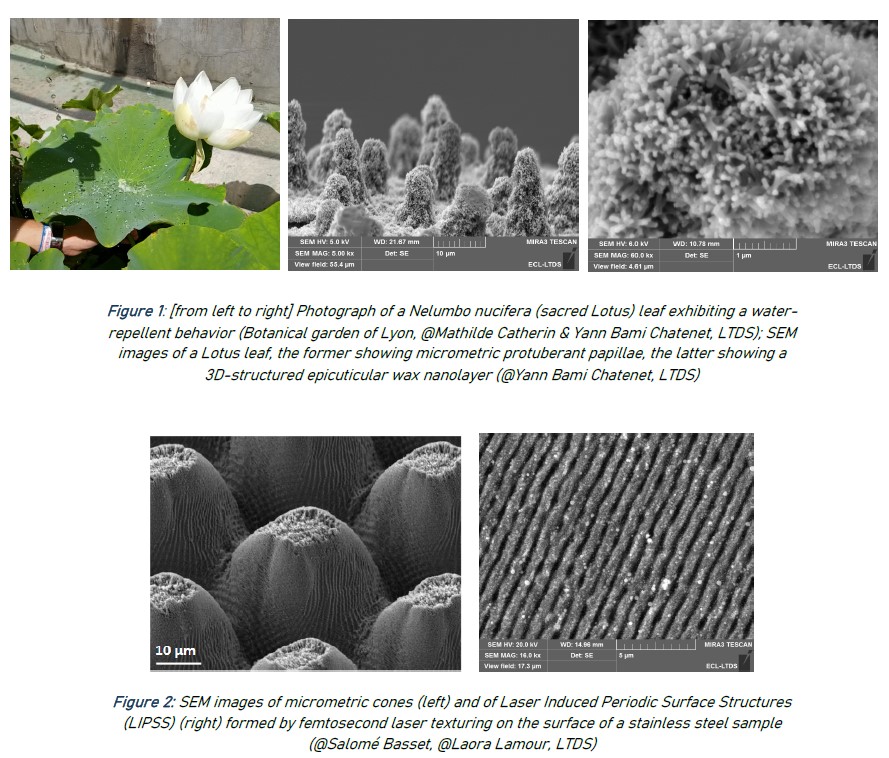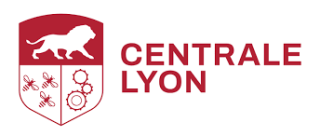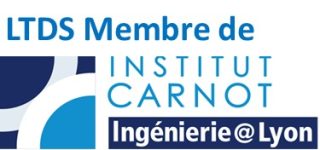Laboratoire de Tribologie et Dynamique des Systèmes | UMR 5513 | Ecole Centrale de Lyon
“Study of the influence of environmental parameters on the evolution of the wetting properties of bio-inspired surfaces textured via femtosecond laser”

Scientific context:
Ultra-short pulses laser texturing of metallic surfaces has emerged in the last decades as a very promising technique to produce surfaces with specific
wetting properties. Indeed, by choosing wisely the texturing parameters and the environment conditions, both super-hydrophilic and super-hydrophobic surfaces can be achieved without the use of harmful chemicals like the perfluorinated compounds (PFAS,…). These kinds of surfaces are needed in many industrial areas. For instance, in the medical field, hydrophilicity is sought to increase cell attachment to metals and permits a good integration of prothesis. In the aeronautics industry, hydrophobic surfaces are needed for their antiicing properties.
Inspiration to design surfaces with well-defined properties can be found in nature.[1] Many plants leaves for example exhibit hydrophobic properties. One of the most studied and famous one is the leaf of the sacred Lotus (Nelumbo nucifera) whose specific chemistry and topography permits it to reach super-hydrophobicity and achieve self-cleaning properties. To be more precise, this wetting state is achieved due to the presence of a double-scale topography with nanometric features rich in carbon covering micrometric cells as it can be seen on figure 1.[2] This specific topography tends to be reproduced with femtosecond laser
texturing. Indeed, periodic nanometric “self”-organized” surface structures (LIPSS) are generated on metallic surfaces when the laser parameters are correctly set and micrometric features are produced easily (figure 2).[3]
However, the chemical surface changes induced by this type of process are not fully understood. Yet, these changes are of major importance in determining the final wetting properties of the surface.[4] Thus, it is essential to have a better understanding of the chemical changes that happens at the metallic surface during and just after laser texturing.
[1] Bhushan et al., “Biomimetics: lessons from nature-an overview”, Phil. Trans. R. Soc. A, 367, 2009, 1445-1486
[2] Barthlott W. et al., « Plant surfaces: structures and functions for biomimetic innovations », Nanomicro Lett., 9, 2017, 1-40
[3] Sun et al., “A review of effects of femtosecond laser parameters on metal surface properties”, Coatings, 2022
[4] Kietzig et al., “Patterned superhydrophobic metallic surfaces”, Langmuir,2009, 4821-4827
Key words:
Wetting, femtosecond laser texturing, bio inspiration, surface chemistry, metals, Laser Induced Periodic Surface Structure (LIPSS)
Stéphane VALETTE and Laora LAMOUR– Internship proposal – LTDS 3
Objective of the internship:
The aim of the internship is to determine the influence of specific processing parameters, that have not been investigated in the team yet, on the wettability properties of metallic surfaces. More precisely, the influence of the gaseous environment on the topography and on the chemistry of the metallic surfaces during and after laser texturing will be investigated. The experiments employed to do so include:
– Surface preparation and storage (polishing, work in glove box)
– Femtosecond laser texturing (pattern designing, texturing in various environments)
– Topographical analyses (Optical microscopy, Interferometry)
– Wetting properties analyses (static goniometry, dynamic goniometry).
Internship run:
Attached to the LTDS laboratory from Ecole Centrale de Lyon, the student will have to work in a scientific multi-disciplinary environment from surface characterization to physics of wetting. The access to high-level equipment at the LTDS and the SURFAB platform will provide to the student a high-level research experience.
Candidate profile:
Due to the multidisciplinary and experimental aspects of the project, the candidate must demonstrate scientific curiosity, great rigor and adaptation capacity. Knowledges in surface science, chemistry and / or material sciences are expected as well as scientific synthesis skills and the ability to have a critical eye on its own results. To finish, qualities in oral and written redaction in French and / or in English are required.
Terms and conditions of the internship:
Supervisory staff: Stéphane VALETTE (ECL, LTDS, Professor)
Laora LAMOUR (ECL, LTDS, 2nd year Doctoral student)
Duration: 6 months, February-September 2025
Location: Laboratoire de Tribologie et Dynamique des Systèmes – Ecole Centrale de Lyon – Ecully
Salary : 590 euros / month





